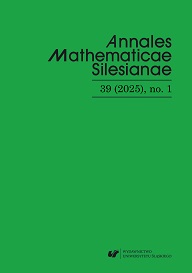A. Alvino, G. Trombetti, and P.-L. Lions, On optimization problems with prescribed rearrangements, Nonlinear Anal. 13 (1989), no. 2, 185–220.
Google Scholar
S. Biagi, S. Dipierro, E. Valdinoci, and E. Vecchi, Semilinear elliptic equations involving mixed local and nonlocal operators, Proc. Roy. Soc. Edinburgh Sect. A 151 (2021), no. 5, 1611–1641.
Google Scholar
S. Biagi, S. Dipierro, E. Valdinoci, and E. Vecchi, A Hong–Krahn–Szegö inequality for mixed local and nonlocal operators, Math. Eng. 5 (2022), no. 1, Paper No. 014, 25 pp.
Google Scholar
S. Biagi, S. Dipierro, E. Valdinoci, and E. Vecchi, Mixed local and nonlocal elliptic operators: regularity and maximum principles, Comm. Partial Differential Equations 47 (2022), no. 3, 585–629. DOI: 10.1080/03605302.2021.1998908.
Google Scholar
S. Biagi, S. Dipierro, E. Valdinoci, and E. Vecchi, A Faber–Krahn inequality for mixed local and nonlocal operators, J. Anal. Math. 150 (2023), no. 2, 405–448.
Google Scholar
L. Brasco, E. Lindgren, and E. Parini, The fractional Cheeger problem, Interfaces Free Bound. 16 (2014), no. 3, 419–458.
Google Scholar
C. Bucur, Some observations on the Green function for the ball in the fractional Laplace framework, Commun. Pure Appl. Anal. 15 (2016), no. 2, 657–699.
Google Scholar
D. Chen and H. Li, Talenti’s comparison theorem for Poisson equation and applications on Riemannian manifold with nonnegative Ricci curvature, J. Geom. Anal. 33 (2023), Paper No. 123, 20 pp. DOI: 10.1007/s12220-022-01162-0.
Google Scholar
Z.-Q. Chen, P. Kim, R. Song, and Z. Vondraček, Sharp Green function estimates for ∆ + ∆^{α/2} in C^{1,1} open sets and their applications, Illinois J. Math. 54 (2010), no. 3, 981–1024.
Google Scholar
Z.-Q. Chen and T. Kumagai, A priori Hölder estimate, parabolic Harnack principle and heat kernel estimates for diffusions with jumps, Rev. Mat. Iberoam. 26 (2010), no. 2, 551–589.
Google Scholar
V. Ferone and B. Volzone, Symmetrization for fractional elliptic problems: a direct approach, Arch. Ration. Mech. Anal. 239 (2021), no. 3, 1733–1770.
Google Scholar
V. Ferone and B. Volzone, Symmetrization for fractional nonlinear elliptic problems, Discrete Contin. Dyn. Syst. 43 (2023), no. 3–4, 1400–1419.
Google Scholar
H. Hajaiej and K. Perera, Ground state and least positive energy solutions of elliptic problems involving mixed fractional p-Laplacians, Differential Integral Equations 35 (2022), no. 3–4, 173–190.
Google Scholar
S. Kesavan, Some remarks on a result of Talenti, Ann. Scuola Norm. Sup. Pisa Cl. Sci. (4) 15 (1988), no. 3, 453–465.
Google Scholar
T. Kulczycki, Properties of Green function of symmetric stable processes, Probab. Math. Statist. 17, Acta Univ. Wratislav. No. 2029 (1997), no. 2, 339–364.
Google Scholar
E.H. Lieb and M. Loss, Analysis, Graduate Studies in Mathematics, 14, American Mathematical Society, Providence, RI, 2001.
Google Scholar
P.-L. Lions, Quelques remarques sur la symétrisation de Schwartz, in: H. Brézis, J.-L. Lions (eds.), Nonlinear Partial Differential Equations and Their Applications. Collège de France Seminar. Vol. I, Res. Notes in Math., 53, Pitman (Advanced Publishing Program), Boston, Mass.-London, 1981, pp. 308–319.
Google Scholar
P. Mironescu and W. Sickel, A Sobolev non embedding, Atti Accad. Naz. Lincei Rend. Lincei Mat. Appl. 26 (2015), no. 3, 291–298.
Google Scholar
G. Talenti, Elliptic equations and rearrangements, Ann. Scuola Norm. Sup. Pisa Cl. Sci. (4) 3 (1976), no. 4, 697–718.
Google Scholar




 10.2478/amsil
10.2478/amsil